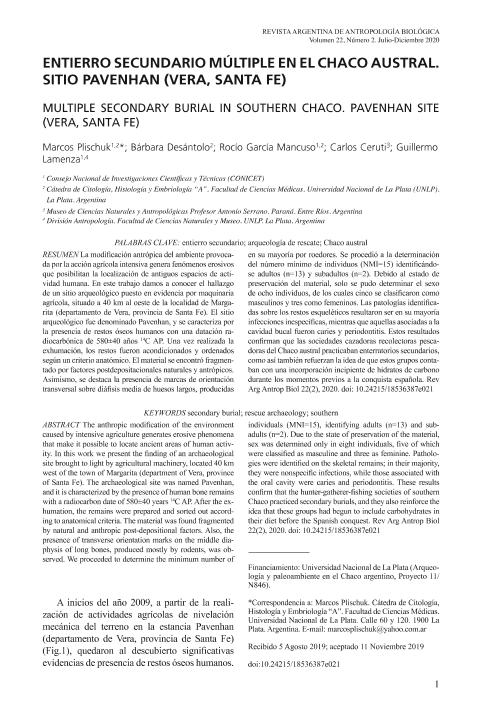Artículo
The anthropic modification of the environment caused by intensive agriculture generates erosive phenomena that make it possible to locate ancient areas of human activity. In this work we present the finding of an archaeological site brought to light by agricultural machinery, located 40 km west of the town of Margarita (department of Vera, province of Santa Fe). The archaeological site was named Pavenhan, and it is characterized by the presence of human bone remains with a radiocarbon date of 580±40 years 14C AP. After the exhumation, the remains were prepared and sorted out according to anatomical criteria. The material was found fragmented by natural and anthropic post-depositional factors. Also, the presence of transverse orientation marks on the middle diaphysis of long bones, produced mostly by rodents, was observed. We proceeded to determine the minimum number of individuals (MNI=15), identifying adults (n=13) and sub-adults (n=2). Due to the state of preservation of the material, sex was determined only in eight individuals, five of which were classified as masculine and three as feminine. Pathologies were identified on the skeletal remains; in their majority, they were nonspecific infections, while those associated with the oral cavity were caries and periodontitis. These results confirm that the hunter-gatherer-fishing societies of southern Chaco practiced secondary burials, and they also reinforce the idea that these groups had begun to include carbohydrates in their diet before the Spanish conquest. The anthropic modification of the environment caused by intensive agriculture generates erosive phenomena that make it possible to locate ancient areas of human activity. In this work we present the finding of an archaeological site brought to light by agricultural machinery, located 40 km west of the town of Margarita (department of Vera, province of Santa Fe). The archaeological site was named Pavenhan, and it is characterized by the presence of human bone remains with a radiocarbon date of 580±40 years 14C AP. After the exhumation, the remains were prepared and sorted out according to anatomical criteria. The material was found fragmented by natural and anthropic post-depositional factors. Also, the presence of transverse orientation marks on the middle diaphysis of long bones, produced mostly by rodents, was observed. We proceeded to determine the minimum number of individuals (MNI=15), identifying adults (n=13) and subadults (n=2). Due to the state of preservation of the material, sex was determined only in eight individuals, five of which were classified as masculine and three as feminine. Pathologies were identified on the skeletal remains; in their majority, they were nonspecific infections, while those associated with the oral cavity were caries and periodontitis. These results confirm that the hunter-gatherer-fishing societies of southern Chaco practiced secondary burials, and they also reinforce the idea that these groups had begun to include carbohydrates in their diet before the Spanish conquest.
Entierro secundario múltiple en el chaco Austral. Sitio pavenhan (Vera, Santa Fe)
Título:
Multiple secondary burial in Southern Chaco. Pavenhan site (Vera, Santa Fe)
Plischuk, Marcos ; Desántolo, Bárbara; Garcia Mancuso, Rocio
; Desántolo, Bárbara; Garcia Mancuso, Rocio ; Ceruti, Carlos Natalio
; Ceruti, Carlos Natalio ; Lamenza, Guillermo Nicolás
; Lamenza, Guillermo Nicolás
 ; Desántolo, Bárbara; Garcia Mancuso, Rocio
; Desántolo, Bárbara; Garcia Mancuso, Rocio ; Ceruti, Carlos Natalio
; Ceruti, Carlos Natalio ; Lamenza, Guillermo Nicolás
; Lamenza, Guillermo Nicolás
Fecha de publicación:
07/2020
Editorial:
Asociación de Antropología Biológica Argentina
Revista:
Revista Argentina de Antropología Biológica
ISSN:
1853-6387
e-ISSN:
1514-7991
Idioma:
Español
Tipo de recurso:
Artículo publicado
Clasificación temática:
Resumen
Palabras clave:
RESCUE ARCHAEOLOGY
,
SECONDARY BURIAL
,
SOUTHERN
Archivos asociados
Licencia
Identificadores
Colecciones
Articulos(CCT - LA PLATA)
Articulos de CTRO.CIENTIFICO TECNOL.CONICET - LA PLATA
Articulos de CTRO.CIENTIFICO TECNOL.CONICET - LA PLATA
Citación
Plischuk, Marcos; Desántolo, Bárbara; Garcia Mancuso, Rocio; Ceruti, Carlos Natalio; Lamenza, Guillermo Nicolás; Entierro secundario múltiple en el chaco Austral. Sitio pavenhan (Vera, Santa Fe); Asociación de Antropología Biológica Argentina; Revista Argentina de Antropología Biológica; 22; 2; 7-2020; 1-15
Compartir
Altmétricas



